Star Hammer: The Vanguard Prophecy – Review
by Mark
|
 Over the past few months I’ve become more enamoured with the world of table-top gaming. There is something about the connection between players sitting around a table that you just don’t get with online gaming, something I’ve missed over the last ten years. One of my favourites at the minute is Star Wars Armada, which sees players command fleets of capital ships and clouds of fighters from the Star Wars universe around the time of the Rebellion. For me, it captures that slow, methodical planning and strategy you’d expect from a fleet battle, and I’ve not seen that duplicated anywhere, not even in the world of video games.
Over the past few months I’ve become more enamoured with the world of table-top gaming. There is something about the connection between players sitting around a table that you just don’t get with online gaming, something I’ve missed over the last ten years. One of my favourites at the minute is Star Wars Armada, which sees players command fleets of capital ships and clouds of fighters from the Star Wars universe around the time of the Rebellion. For me, it captures that slow, methodical planning and strategy you’d expect from a fleet battle, and I’ve not seen that duplicated anywhere, not even in the world of video games.
That was until I happened across a little game on Steam, Star Hammer: The Vanguard Prophecy. When I saw the visuals I can’t say I was convinced, but reading a comment from another Steam user who described the title as “Star Wars Armada, the video game”, I was sold.
Star Hammer, a turn-based strategy published by Slitherine and developed by small Australian team Black Lab Games, sees humanity fleeing a spoiled and polluted Earth in search of a new home. A century of travel brings the human colony fleet to a planet known as Novus, and a long process of colonisation begins. The new colony at Novus find that life outside of Earth’s protection is harsh, and a war with the alien Nautilids breaks out, eventually coming to an end due to the acts of some heroic figures within the human force. The Vanguard Prophecy takes place fourteen years after this war; with humanity so wrapped up in its own political strife it doesn’t see the coming threat. You play as Lieutenant Valeron Dyce, daughter of Admiral Dyce – a hero from the aforementioned war – as you rise through the ranks and meet a new threat, all while dealing with your father’s shadow.
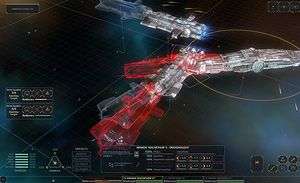 Much of the story is delivered via mission text, background reading in the mission-select screen and comm chatter between characters during missions. There is no voiceover within the game, so expect a bit of a read, however, the quality of the writing is high and if you take the time to read you will start to see a fairly decent plot develop. Unsurprisingly, the Nautalids do return, and over a series of missions you begin to build a fleet that will be used to stop them. There are some surprising twists throughout along with the odd bit of language I can only imagine was implemented due to Australia’s crazy censorship laws.
Much of the story is delivered via mission text, background reading in the mission-select screen and comm chatter between characters during missions. There is no voiceover within the game, so expect a bit of a read, however, the quality of the writing is high and if you take the time to read you will start to see a fairly decent plot develop. Unsurprisingly, the Nautalids do return, and over a series of missions you begin to build a fleet that will be used to stop them. There are some surprising twists throughout along with the odd bit of language I can only imagine was implemented due to Australia’s crazy censorship laws.
As you progress you will begin to pick up new crew members who all get across a sense of personality, despite them all being a tad cliché. From the super-loyal junior gunnery officer who will defend you to the death, to the tough-as-nails rival who doesn’t understand how you’ve risen through the ranks – suggesting that your father’s influence was involved – each crew member adds something different, be that personality or skills.
Crew members level up as you progress through the missions, generally adding things like percentage bonuses to weapon damage, or increasing your ship’s speed. The key to success in the game is balancing these out between an ever-expanding crew where you have a limited number of spaces on the bridge. Due to personalities, you’ll also find that some crew members work better together than others adding an extra dimension to seemingly complex levelling system.
 |
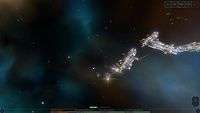 |
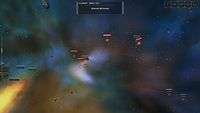 |
 |
 |
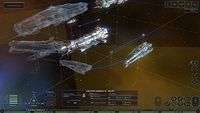 |
The mission screen acts as the hub to an entire campaign within Star Hammer. There is a choice of missions, not all have to be completed to progress the story (although you find it’s typically best to get through everything for those sweet experience points). Depending on how you complete missions and level characters, there is the warscale, which can be either offensive, tied to the destruction of enemy ships etc, or defensive, which is based on how little damage you take. Sadly very little of this is explained in-game, and it’s not until you’re a good few missions deep that you realise this is quite an important resource to track. Depending on where your warscale resource is at any one time will determine your access to some of the missions within chapters, and you find that they are locked to you completely. I’m not sure of the significance of this as I’ve only played through once, and couldn’t say how different this makes the story or the experience, but does add a little replay value to the game.
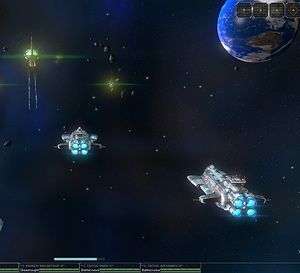 Each mission begins with a deployment screen, where you decide the make-up of your fleet, order reinforcements, and set the formation. All of these become quite important as ships also gain experience, receiving bonuses to things like movement, speed, and shield strength. Do you take your experienced ships on a fairly easy mission and risk losing them if it becomes too dangerous? Or use only your experienced ships, and feel their loss even more if they are destroyed and have to be replaced with inexperienced crews. You end up in a situation similar to XCOM: Enemy Unknown’s squad management, switching between experienced ships to ensure you’re not left short handed. Formations are also important in that you are often attacked straight from the first turn, and small ships are very vulnerable to being annihilated. Group them too close and you then have to spend a few turns trying to avoid crashing in to each other.
Each mission begins with a deployment screen, where you decide the make-up of your fleet, order reinforcements, and set the formation. All of these become quite important as ships also gain experience, receiving bonuses to things like movement, speed, and shield strength. Do you take your experienced ships on a fairly easy mission and risk losing them if it becomes too dangerous? Or use only your experienced ships, and feel their loss even more if they are destroyed and have to be replaced with inexperienced crews. You end up in a situation similar to XCOM: Enemy Unknown’s squad management, switching between experienced ships to ensure you’re not left short handed. Formations are also important in that you are often attacked straight from the first turn, and small ships are very vulnerable to being annihilated. Group them too close and you then have to spend a few turns trying to avoid crashing in to each other.
Once you’ve set up your fleet, the mission begins. Combat is played out over a series of turns, with each of your ships having a projected path through the map. Ships travel along these paths automatically firing at enemy crafts that fall within their weapons’ firing arcs. You can set the priority targets if needed, but I managed to get through fairly easily relying on the AI to pick its targets. As I said before, you can collide with your own ships and this is a real danger when engaging in massive fleet battles, so position is everything. Destroyed ships will also serve as drifting obstacles that you have to navigate around, as any collision will knock your engines offline and deal some significant hull damage, with smaller ships simply exploding on contact. Luckily space is a 3D environment, and navigating around is incredibly easy, moving between planes in order to dodge asteroids or drifting enemy ships.
Each ship has a power level, and this also plays a pretty important role in the strategy, with players having to manage how much power should be going to the shields (always best to have them double front, I find) while sacrificing speed and weapon damage. The various ship classes also have a specific role within your fleet. The destroyer, for example, acts as a sniper, using its heavy forward laser to deal massive amounts of damage to a single target, whereas the frigate acts as support, with an anti-missile defence system and stunning ion cannon on its prow. You will also find that missiles and torpedoes resupply very slowly between missions, which adds another layer of strategy to the campaign as you have to manage your weapon fire carefully during battle.
 The combat is fairly easy to get to grips with and the layers to the fleet and resource management really keep it enjoyable for a strategy nerd like myself. When you are in the thick of a massive fight, which tend to be dotted evenly throughout the missions, you really feel the pressure. I found myself, much like I did in XCOM, feeling the loss of a single ship heavily because I didn’t think far enough ahead, or let it collide with an enemy hulk rather than repositioning it. The combat can be unforgiving and challenging, but that’s not really a bad thing and really adds to the realism I think Black Labs are going for. Once you’ve completed the campaign there is also a great skirmish mode, which is essentially straight combat between your fleet and the Nautilids.
The combat is fairly easy to get to grips with and the layers to the fleet and resource management really keep it enjoyable for a strategy nerd like myself. When you are in the thick of a massive fight, which tend to be dotted evenly throughout the missions, you really feel the pressure. I found myself, much like I did in XCOM, feeling the loss of a single ship heavily because I didn’t think far enough ahead, or let it collide with an enemy hulk rather than repositioning it. The combat can be unforgiving and challenging, but that’s not really a bad thing and really adds to the realism I think Black Labs are going for. Once you’ve completed the campaign there is also a great skirmish mode, which is essentially straight combat between your fleet and the Nautilids.
Visually, Star Hammer: The Vanguard Prophecy won’t be winning any awards. Human ship models are detailed and well-textured, sporting working weapon turrets; I particularly love the design of the Dreadnought, but don’t expect much in the way of visual effects from this engine. Weapon effects, from laser blasts to missiles are a little blocky and ships will smoke when damaged, however most of the time you are looking at the action from a high isometric view and rarely see much detail. The UI is a poor during the mission select and deployment screens, albeit a little easier to manage during combat. I put this down to the colours that have been selected; it’s incredibly dark in places where the background is effectively space.
Ship damage is also a little strange; the human ships when destroyed will catch fire and sink from the map while Nautilid ships simply flash and go grey, making me wonder if this was by design or simply the budget. The same could be said for the sound – given that there is no voiceover in the entire game, yet the music consists of what I’d describe as the musak playlist from a sci-fi elevator. Weapon and missile effects are all fairly standard and nothing really jumps out at you as particularly impressive or not.
While visually the game isn’t anything to shout about, it does deliver an impressive strategy experience, mixed with some resource management and RPG elements. The story is fairly solid, albeit told through mountains of text, and you really get the sense that you are struggling to survive in an unforgiving war. If you enjoy sci-fi, huge fleet battles, and weird alien tentacle ships then this might just be the game for you.
Pros- Unique fleet combat
- Despite the odd language used, it's an interesting story
- Interesting cast of characters
- Visuals are a little lacking
- So much reading!
That Steam user was right, Star Hammer is basically Star Wars Armada: The Video Game, and that makes me a very happy geek. It captures perfectly that tactical fleet experience, the strategy of positioning a fleet and the resource management you find in Armada. It brings to life that scale in everything but the clouds of fighters. Ships collide, broadsides are lined up and fired in to walls of alien ships firing strange organic muck your way. I bought the game looking only for the combat experience and found a fairly decent story wrapping it all up. I was pleasantly surprised by Star Hammer, and highly recommend it if you’re a fan of strategy.
Last five articles by Mark
- I Have A Problem
- Total War: Warhammer - Review
- Rainbow Six Siege - Review
- Mordheim: City of the Damned - Review
- Star Wars: Battlefront - Review



















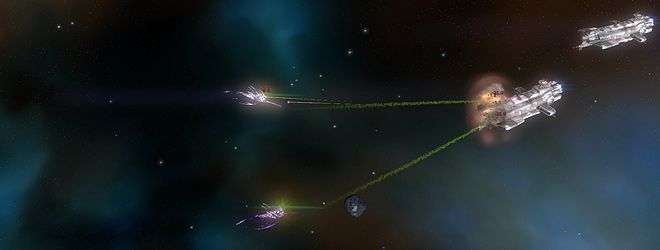






Looks decent, will check this out at some point. Is there mod support for this? Would be cool if someone actually went and made a Star Wars mod for it, or even a Battlestar Mod.
Looks brilliant and maybe I’ll add it to the queue!
Top read dude.